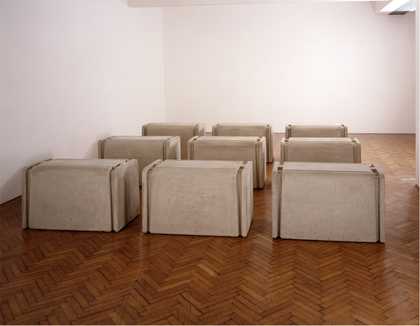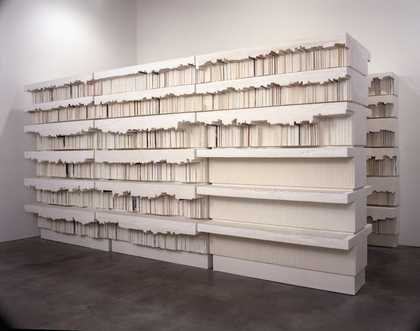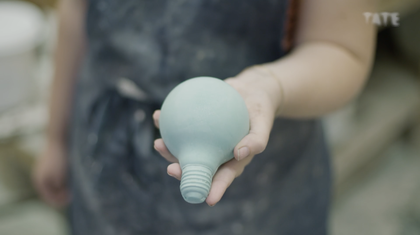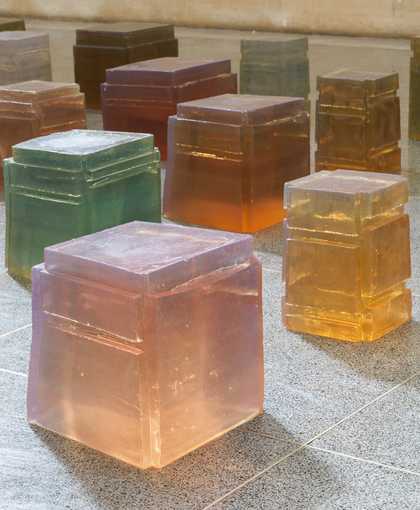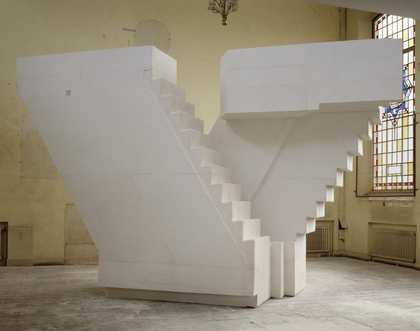
Rachel Whiteread
Untitled (Stairs) 2001 Tate © Rachel Whiteread
Born in 1963, Rachel Whiteread has lived and worked for most of her life in London. She studied painting at Brighton Polytechnic, and sculpture at the Slade School of Art, London. In 1991 she was first nominated for Tate’s Turner Prize, becoming the first woman to win in 1993. Her spare sculptures are made using the technique of casting, with materials such as plaster, rubber, resin, concrete and metals. Unlike traditional cast sculpture, which is intended to replicate objects, Whiteread’s works instead cast the space inside or around everyday forms – such as furniture or boxes – or architectural structures – such as floors, staircases or entire rooms – recording their surfaces and allowing their shapes to determine the form of her sculpture. In this way she explores the human imprint on our everyday environment.
Key to Whiteread’s development as an artist are the public projects that have punctuated her career, documented as an introduction to this exhibition. The first of these was House 1993, a concrete cast of the inside of a Victorian terraced house in London’s East End, which stood for only 80 days before it was demolished. Other significant public commissions have included a translucent resin cast, Water Tower 1998, in New York; a concrete inverted library, Holocaust Memorial 2000, in Vienna; Monument 2001, which stood on the empty fourth plinth in London’s Trafalgar Square; and a more recent series of Shy Sculptures – huts or sheds cast in concrete and situated in remote locations such as by a fjord in Gran in Norway, on a hill on Governor’s Island, New York and in the Mojave desert in California.
This exhibition offers the opportunity to experience three decades of Whiteread’s sculpture, exploring its range over time, working on an intimate, as well as monumental – but always human – scale. Her very particular approach to the process of casting is demonstrated in major works and groups of sculptures exploring the different qualities of materials from plaster and resin to an expanded use of paper, in pulped form, as a sculptural material. Also included is a range of drawings the artist produces as a way of working through her ideas. On the lawn outside Tate Britain a new concrete sculpture, Chicken Shed 2017, will sit during the exhibition. Untitled (100 Spaces) 1995, a major early installation of resin casts of the undersides of chairs, is exhibited in the Duveen Galleries, alongside work from Tate’s collection selected by Rachel Whiteread with Tate curators.
Curated by Ann Gallagher and Linsey Young. Assisted by Helen Delaney and Hattie Spires.
This exhibition is co-organised by Tate Britain and the National Gallery of Art, Washington.
PUBLIC COMMISSIONS
An important aspect of Whiteread’s work is the range of public commissions she has undertaken throughout her career. Included in this exhibition are photographs, models and other documentation related to these projects, among them House 1993 in East London, Water Tower 1998 in New York, the Holocaust Memorial 2000 in Vienna, and Monument for the fourth plinth in Trafalgar Square, 2001. Also documented are a recent and growing series of works she has called her ‘shy sculptures’, structures cast from huts, sheds and cabins, often situated in discreet locations in the landscape and requiring a journey to reach them.
EARLY WORKS
In 1988, a year after graduating from the Slade School of Art, Whiteread held her first solo exhibition at the Carlile Gallery in London, showing works that began her exploration of small domestic objects and furniture – plaster casts of a dressing table, a clothes cupboard, the underside of a bed and a hot-water bottle. They encapsulated the interests that were to define Whiteread’s career over the next thirty years – the process of casting forgotten space, an experimental use of materials and the emotional power of everyday objects.
Whiteread soon expanded her range of materials to include rubber, resin and concrete. She captured architectural features, such as sinks, baths and elements commonly found in the home, and furniture like tables, chairs and mattresses. She found inspiration in objects discarded on the streets, and in the second-hand and junk shops of London which she has referred to as her ‘treasure troves and … sketch books’.
ROOM 101
Untitled (Room 101) 2003 is a plasticised plaster cast of a room in Broadcasting House, the British Broadcasting Company’s headquarters when novelist George Orwell worked there during the Second World War. The room is believed to have inspired Room 101, the chamber of horror in Orwell’s dystopian masterpiece Nineteen Eighty-Four. Whiteread’s cast of the room is all that remains of this literary artefact. Every element of the room’s surface, including the cracks in a wall or the space between skirting boards and floors, was painstakingly prepared before the room was cast in sections, and the original walls removed.
TORSOS
Whiteread’s Torsos are made by pouring materials such as resin, plaster, aluminium leaf, wax, concrete or rubber into a hot water bottle - or a similarly shaped object, an enema bag - and then removing the outer cast from the set material. This results in small and physically unassuming sculptures that nevertheless have an enormous emotional resonance, as a reminder of their original function. The Torsos have been produced since 1988, although while at art school Whiteread was already experimenting with such objects. The creased lines and bulbous shape of the Torsos lend them an almost human quality, and the artist has described them as her ‘headless, limbless babies’.
WORKS ON PAPER
Works on paper have long been a significant, though seldom seen, aspect of Whiteread’s practice. The artist has referred to them as enabling her to work through her ideas, but they are a unique and separate part of her practice. Using a range of paper stock from commercial graph paper to cartridge paper, they have often expanded beyond drawing, typically in pencil, ink, gouache or correction fluid, and into collage. Photographic images of houses, boxes or staircases, often isolated on a background of paper, appear to float in space. The texture and volume of objects depicted are central to these works, which may relate to sculptures of the same subjects.
TABLES AND BOOKSHELVES
Whiteread has often cast the underside of domestic tables and chairs, but from the mid-1990s she began making sculptures cast from groups of tables of
the kind found in offices or institutional settings, and a series of works relating to bookshelves and libraries. Both of these series are associated with the lengthy process of planning and making the Holocaust Memorial 2000 in Vienna (a model of which is included in the display of public projects at the entrance to the exhibition) which takes the form of an inverted, impenetrable library. Like the concrete cast memorial, the books on the library shelves are cast with the spines positioned inwards, but in these plaster works the books are not of uniform size, and the colours and other details of the page edges are recorded during the casting process.
COLOURED OBJECTS
Around the time Whiteread had completed a number of large-scale projects, culminating in Embankment 2005 for Tate Modern’s Turbine Hall, Whiteread decided to devote time to the development of small-scale works where she could physically manage every element of production – something that is impossible on large-scale commissions that require the skills and expertise of many people. Works from this period such as LINE UP, Untitled (Hive) II (both 2007–8) and DRILL 2008 are characterised not only by their relatively small scale and the casting of very unassuming materials such as toilet paper tubes, cardboard boxes and polystyrene packaging, but also by the range of jewel-like colours that the artist employs.
BOXES
Whiteread’s assemblages of plaster casts of boxes such as CONTENTS 2005 were produced during the period she was working towards Embankment 2005, her Turbine Hall commission at Tate Modern. The boxes here, and those Whiteread cast in polyethylene for her Turbine Hall installation, relate directly to her experience of encountering multiple cardboard boxes during the years of moving her own house and studio, and chancing upon boxes she remembered from childhood when sorting through her late mother’s possessions with her sisters. This quiet, measured approach to tracing an object in multiple ways demonstrates how Whiteread communicates the raw emotional power and poignancy of a task that everyone experiences at some point in their lives.
STAIRS AND FLOORS
Alongside the public projects Whiteread was engaged with around the turn of the 21st century she also turned to making work from her own domestic environment, a former textile warehouse and previously synagogue in East London. Before she and her family moved their home and studios into the building, she began the process of casting its interior. A number of key works were developed during this time including Untitled (Stairs) 2001. Whiteread was particularly drawn to the stairs and floors of the building, the spaces which experience the hardest use and which, in their worn patches, scratches and chips, bear witness to the comings and goings of daily life. In capturing these physical marks the artist was able to commemorate the former residents of the building, and some of the many waves of immigration upon which London is built.
WINDOWS AND DOORS
Whiteread has always been concerned with the fabric of buildings, and particularly of their interior features and fixtures such as sinks and baths, light switches and door handles, all of which she has cast. She began casting the surfaces of doors to make sculpture in 2004, and later windows, first in opaque materials such as plaster, and then in a range of coloured resins. The doors are exhibited leaning against walls on the floor and the windows are secured to gallery walls at roughly the height of a domestic window. The range of original subjects is varied; some doors and windows are clearly from older buildings, while others appear to be derived from newer, more modern architectural features. Such a re-imagining of this range of forms in their cast versions, as sculpture, emphasises their details and our relationship with the structures that surround us.
SHEDS AND PAPIER MÂCHÉ
Wall (Apex) 2017 is one of number of shed sections cast from pulped paper, detritus from Whiteread’s studio including exhibition invitations. Depending on the assortment of papers used, the resulting sculptures contain a rich array of colours. The artist used papier mâché for her very first experiments in casting and recently returned to this humble material to make small-scale framed sculptures, some of which have had paint applied in delicate patterns, a reminder of the artist’s beginnings as a painter. The concrete Chicken Shed 2017 is on display in the Millbank Garden.

